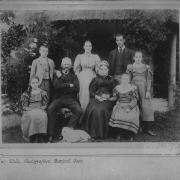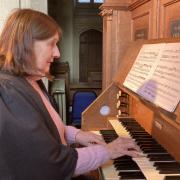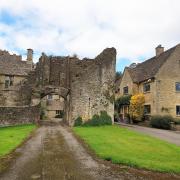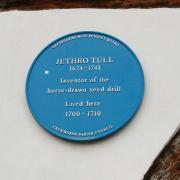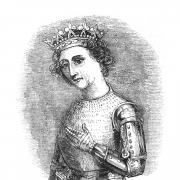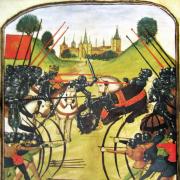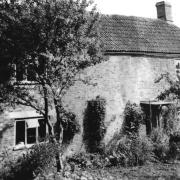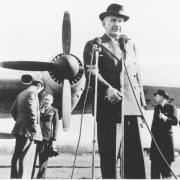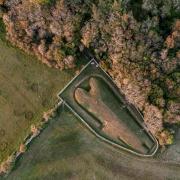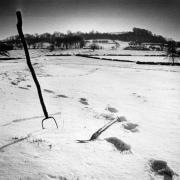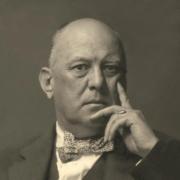The team at Gloucestershire Archives dust off the documents
Photograph of the Month
As winter approaches and the roads become more tricky to negotiate, we pay a visit to a car crash that appeared in the pages of the Cheltenham Chronicle & Gloucestershire Graphic of May 1929. The picture shows a ‘motor-laudette’ that left the road near to Gilbert’s Grave, about three miles south-west of Bourton-on-the-Water on the Cirencester main road. Laudettes or Landaulets were a type of vehicle where the rear passengers were covered by a convertible top, with the driver often being separated from the rear passengers by a partition, as in a limousine. This particular laudette belonged to Messrs W. G. Bridges & Son of Cirencester, who were automobile engineers with offices and a showroom in Castle Street. The vehicle was returning a party of seven people to Bourton when the accident occurred. How it happened is not known, although the road looks like it may be wet, so possibly that was the cause. Whatever the reason, the car careered off the road, down the roadside bank and smashed through the fence, whereupon its right front wheel was torn off. Luckily the car did not overturn and no-one was apparently hurt. Unfortunately, the number plate of the car cannot be read, otherwise the Gloucestershire vehicle license registration records that are held in the archives could have been used to identify the make and model.
Spotlight on Maps

This compass rose is from a map entitled ‘Lands enclosed at Dyrham Park’, but could be taken from many maps in the archives. These often highly decorated objects have an interesting little backstory. Firstly, north is always the largest, most decorative of the cardinal points shown, typically an arrow or spear head (the accepted symbol for the head of a compass’ magnetic needle). However, during the Renaissance, Portuguese cartographers began using the ‘fleur de lys’ instead, probably because of its religious and political meanings (being a symbol of the Virgin Mary and a heraldic sign of nobility and royalty). The only other cardinal point that had a special marking was east, which was marked by the sign of the cross. This was because it symbolically represented the direction towards Jerusalem, the place where Jesus was crucified and buried. In addition, cardinal points can be marked in Latin and some even used the mariner's principal winds (ie T – tramontana (north), L – levante (east), O – ostro (south), P – ponente (west), etc). Lastly, a word of warning – be aware that on many old maps, north is not always at the top!
Document of the Month

Famous for its trout fishery, its woods and the Chedworth Roman villa, the sale of Stowell Park Estate by the elderly Lord Eldon in July 1923 made for a lot more interest than this page from the sales particulars for the property might suggest. Initially offered as one lot, the first auction fell through when the newly appointed Lord Vestey approached Lord Eldon directly before the auction and bought six of the lots – including the mansion, the park, Yanworth Farm, Yanworth Mill and Raybrook Farm, amounting to some 4,000 acres – for £63,000. Vestey was one the Vestey Brothers, a huge shipping and meat packing company and he was not considered worthy of ennoblement because the brothers had moved the business out of the country in 1915 to avoid paying millions of pounds in tax. However, despite opposition from King George V, Vestey received a peerage title from Lloyd George in 1922, after making a £20,000 donation to the Liberal Party. This helped trigger the ‘Lloyd George honours scandal’ and subsequently paved the way for the Honours (Prevention of Abuses) Act 1925. The remainder of the estate was then re-offered up for sale in the original lots and eventually sold at an auction on September 17.
Gloucestershire Character

This dapper looking gentleman is Ernest J.C. Palmer, who was known in Gloucester as ‘Picturedrome Palmer’, because he owned the Picturedrome Theatre on Barton Street. Born in Gloucester in 1872, he served in the army in South Africa but later became a grocer with a shop at 21 Lower Barton Street. He retained a lifelong interest in the welfare of soldiers, sailors and their families. This drove him to become a pioneer of on-street money-raising for charities - on most Sunday mornings he could be seen at the Cross in Gloucester collecting. In 1906, he helped set up the Gloucester branch of the Dickens Fellowship (at the time this was only the second branch outside London) which was very active in offering entertainment to its members and raising money for local good causes. In 1907 he organised a scheme for helping Gloucester’s unemployed, introducing ‘halfpenny meals’ to feed the hungry. Possibly his strangest effort was when he wore a dog’s collar to raise funds to buy HMS Gloucester a new mascot, a bull terrier called Bounce II (he had also fundraised to buy an earlier mascot, Bounce I, who’d retired).
Gloucestershire Archives, Clarence Row, Alvin Street, Gloucester, GL1 3DW, gloucestershire.gov.uk/archives
Follow Gloucestershire Archives on Twitter: @GlosHeritageHub




